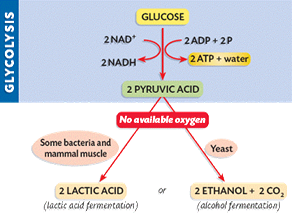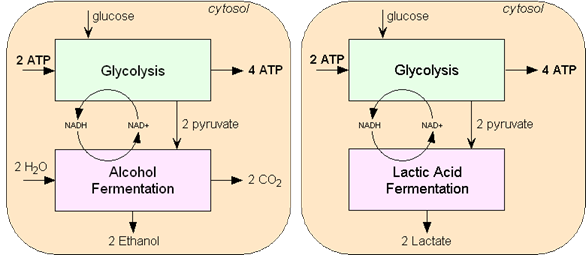CELLULAR RESPIRATION
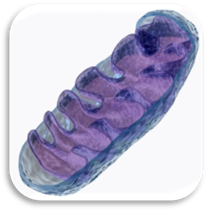
In the
last unit you learned of the two processes (photosynthesis and chemosynthesis)
which some cells carry out in order to produce food or chemical energy for
other organisms. In this unit we will look at the process which all
cells utilize in order to convert the energy that is produced by photosynthesis
or chemosynthesis into a usable energy form for cells. In this process, known
as cellular respiration, energy is released from the chemical bonds of the food
(biomolecules) consumed and then transferred to ATP. Cellular respiration does
not only involve the carbohydrates made from photosynthesis or chemosynthesis
but also proteins and lipids. Remember from previous units about the structure
and importance of ATP and how a cell needs this molecule in order to have a
usable form of energy. In other words, a cell can have all the sugar it wants,
but if the energy in the sugar is not converted to ATP (process of cellular
respiration) then that energy is useless to the cell.
Mitochondria
The
process of cellular respiration occurs in the organelle know as a mitochondrion
(singular) or mitochondria (plural). Mitochondria were mentioned in Unit 6 -
Cell. Here we will examine the mitochondrion in a little more detail. The
mitochondria are nicknamed the “powerhouse” of the cell, because this is
where cellular respiration occurs which produces all of the ATP (usable energy)
for the cell. Cells which require a great amount of energy will contain more
mitochondria than other cells which may not require as much energy. Muscle
cells and liver cells are examples of cells within us that require more energy
(ATP) and therefore more mitochondria than other cells such as skin cells. In
eukaryotes, you will find mitochondria for the process of cellular
respirations. In prokaryotes, remember they have no membrane-bound organelles,
cellular respiration occurs in their plasma membrane.
Mitochondria
are double membrane organelles. The outer membrane is smooth while the inner
membrane has many folds so to increase surface area. Having more of this
inner membrane allows for more cellular respiration reactions. Just as we
mentioned how different cells can have greater or lesser amounts of
mitochondria in their cells, the mitochondria themselves may have more inner
membrane folds than others. These inner membrane folds are called cristae.
These two membranes also create two spaces within the organelle. The space
between the inner membrane and outer membrane is called the intermembrane
space. The space totally enclosed by the inner membrane is called the matrix.
It is on this inner membrane and matrix where many of the ATP-producing enzymes
are found.
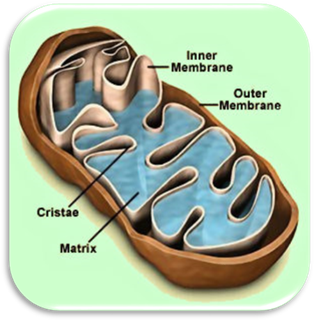
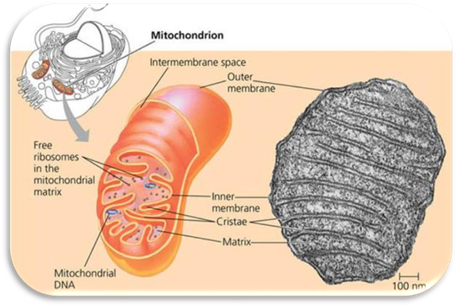
Cellular
Respiration Overview
Cellular
respiration is a process that involves a set of metabolic reactions by which
the cell produces energy from carbohydrates. The overall cellular respiration
reaction involves using glucose (C6H12O6) and
oxygen gas (O2) to produce water (H2O), carbon dioxide
gas (CO2) and most importantly ATP.

Carbon
Cycle
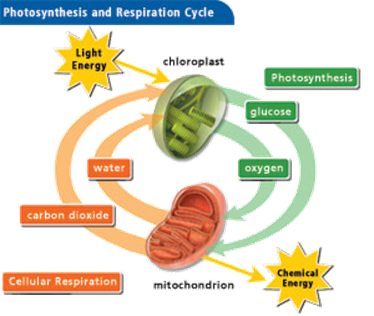
The
reaction of cellular respiration in conjunction with the reaction of
photosynthesis are the major parts of the carbon cycle. Metabolism involves using energy to either build organic molecules
or break down organic molecules. When breaking down organic molecules, chemical
bonds are broken and that is when energy is released. Organic molecules are
molecules made with carbon. The fact that photosynthesis produces the organic
molecule and cellular respiration uses that organic molecule makes these two
reactions major players in the carbon cycle. Not only are they cycling carbon
through the environment, but they are also cycling chemical energy.
Recall
that photosynthesis is the process which uses sunlight to produce organic
molecules, more specifically carbohydrates (sugars). Cellular respiration is
the process that will release the energy from that carbohydrate and produce ATP
for the cell to use. From the cellular respiration reaction above, you see that
carbon dioxide is produced when the glucose (sugar) is broken down. That carbon
dioxide will be used by photosynthesis to produce carbohydrates again.
The following video
segment defines glycolysis, citric acid cycle (Krebs cycle), and the electron
transport chain.
Cellular
respiration occurs in a series of stages. The three main stages of cellular
respiration are glycolysis, the citric acid cycle, and the electron
transport chain.

The first
stage of cellular respiration is glycolysis which translated means
“splitting sugars”. In glycolysis, glucose (C6H12O6),
which is a six-carbon sugar, is broken down with the help of enzymes into two
three-carbon sugars called pyruvate molecules.
The process begins using two ATP molecules and in
the end of glycolysis four ATP molecules are produced, so it is said that there
is a net gain of 2 ATP molecules in glycolysis.
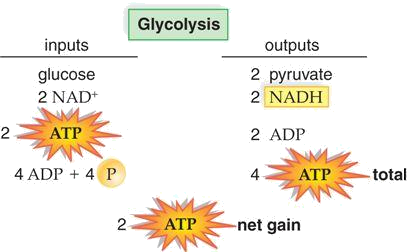
|
Aerobic Respiration |
|
Any
cellular process that requires oxygen is described as aerobic. Any
cellular process that does not require oxygen is described as anaerobic.
Stage 1 – Glycolysis is an anaerobic process. Aerobic Respiration continues
after glycolysis with the two pyruvate molecules that were produced, if
oxygen is present. Essentially the two pyruvates are converted into many ATP
molecules. Aerobic Respiration is the most efficient method of producing ATP.
Aerobic Cellular Respiration involves two steps: Citric Acid Cycle and
Electron Transport Chain. |
|
|

The Citric Acid Cycle is also known as
the Krebs Cycle. The cycle is named after the German biochemist Hans Adolf
Krebs. Hans Adolf Krebs identified the citric acid cycle in 1937. To learn more
watch the following video.
The Citric
Acid Cycle involves a series of biochemical reactions that convert the
pyruvate from glycolysis into carbon dioxide, water, and more importantly ATP,
NADH (electron carrier), and FADH2 (electron carrier).


The
electron transport chain occurs on the inner membrane of the mitochondrion. The
more cristae present within the mitochondrion, the more electron transport
chains possible, therefore the more ATP that will be made. In photosynthesis,
you learned about an electron transport chain. This electron transport chain is
similar in terms of the process.
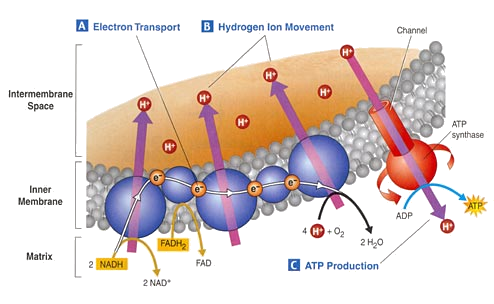
The electron carriers (NADH and FADH2) that were produced in
the Krebs cycle will now pass through this electron transport chain. The
electrons that NADH and FADH2 bring to the electron transport chain
will be released and pass through this chain releasing their energy to
molecules within the membrane. Hydrogen ion pumps are some of the membrane
molecules that energy from the electrons is pass to.
The energy
from the electrons have the hydrogen ion pumps move hydrogen ions outside of the matrix. As hydrogen ions
accumulate outside the inner membrane of the mitochondria a higher
concentration of hydrogen ions is created outside the inner membrane.


Now that there is a higher concentration of hydrogen ions outside the
inner membrane, hydrogen ions will begin to diffuse naturally (passive
transport) back through the inner membrane. The hydrogen ions use the membrane
protein/enzyme “ATP Synthase” to diffuse back into the matrix. As the
hydrogen ions diffuse through the ATP Synthase the energy created is used to
produce up to 34 ATP molecules.

If no
oxygen is present or available then the electron transport chain stops, no
electron carriers can be recycled, and the only ATP produced is as a result of Stage 1 Glycolysis. As you can see it is
very important to keep a supply of oxygen available to keep aerobic cellular
respiration working in order to produce the most ATP molecules possible.
|
Anaerobic
Respiration |
|
At
the end of Stage 1 Glycolysis, sometimes oxygen is not available. If no
oxygen is available the cell then undergoes anaerobic respiration. |
|
|
|
|
|
Instead
of the Krebs cycle and electron transport chain that is used in aerobic
respiration, anaerobic respiration will use the process of fermentation to recycle NAD+
which is needed to continue making ATP in Stage 1 Glycolysis. In other words,
fermentation is necessary to keep glycolysis working when no oxygen is
present so ATP is still being produced. There are two types of fermentation: Lactic Acid Fermentation and Alcoholic Fermentation. |
|
Lactic Acid Fermentation |
|
Lactic
acid fermentation involves converting the pyruvates from the end of stage1
glycolysis into lactic acid while using the electrons and hydrogen ions from
NADH. Using NADH will keep glycolysis going so to recycle NADH and to keep
producing ATP. Lactic acid fermentation occurs in animal cells, more
specifically muscle cells, and some bacteria. As muscle cells go through
vigorous exercise or intense work, they must continue to operate even though
there may not be enough oxygen for aerobic respiration. When these muscle
cells do not have enough oxygen they will work under anaerobic respiration
(lactic acid fermentation). Lactic acid fermentation will at least produce
some ATP, by recycling NADH in glycolysis, to supply the muscle cells with
some energy. The product of lactic acid fermentation is lactic acid. Lactic
acid will build up in a muscle causing the muscle to become tired and sore at
that moment, soreness found later involves something else. Keep in mind, no
ATP is made in lactic acid fermentation, it is only made in glycolysis when no
oxygen is present. |
|
|
|
|
|
Alcoholic
Fermentation |
|
Alcoholic
fermentation involves converting the pyruvates, from the end of stage 1
glycolysis, into ethanol (ethyl alcohol), while releasing carbon dioxide (CO2)
and using the electrons and hydrogen ions from NADH. Using NADH will keep
glycolysis going so to recycle NADH and to keep producing ATP. Alcoholic
fermentation occurs in some bacteria and fungi. If you have ever watched
bread dough rise, you are watching the yeast (fungi) eat the sugar in the dough
and undergo alcoholic fermentation producing carbon dioxide and ethanol. The
bread rises as a result of the carbon dioxide bubbles inside the dough while
ethanol is produced in the process. However, through the bread baking process
the ethyl alcohol will evaporate out of the bread. |
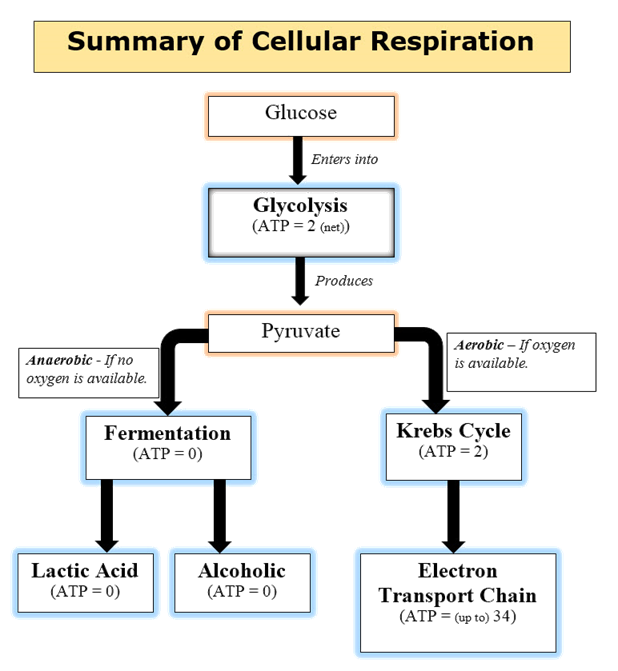
UNIT VOCABULARY REVIEW
